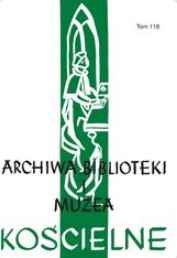Posługa opiekuńcza duchaków i kapucynów w Szpitalu Świętego Ducha w Rzymie w XVII-XVIII wieku
CARE MINISTRY OF THE HOSPITALLERS OF THE HOLY SPIRIT AND CAPUCHINS AT THE HOSPITAL OF THE HOLY SPIRIT IN ROME IN THE 17TH-18TH CENTURIES
Author(s): Marian SurdackiSubject(s): Christian Theology and Religion, Theology and Religion, Other Christian Denominations, History of Religion
Published by: Katolicki Uniwersytet Lubelski Jana Pawła II - Wydział Teologii
Keywords: Hospital of the Holy Spirit; Rome; the sick; canons; Capuchins; Reformanti; nursing; care
Summary/Abstract: During the Middle Ages and the post-Tridentine period, hospitals as institutions under ecclesiastical administration were places where special care was taken for the religious life of their patients. Care was administered with equal concern for the physical cure of the sick as for the salvation of their souls. This was also the case at Rome’s Hospital of the Holy Spirit, founded in 1198 by Pope Innocent III. The religious and spiritual life of its patients was shaped by the permanently resident Canons Regular of the Holy Spirit, often assisted by priests from other orders. From its inception, the hospital consisted of two institutions – a shelter for foundlings and an infirmary.This text focuses on the service, care and nursing work performed on behalf of the sick by both local canons of the Holy Spirit and priests and monks from outside the hospital, mainly Capuchins or Reformanti, who were hired to assist the lay staff during the increased influx of the sick. For example, in 1759, 14 Capuchins were invited to help, with that number reaching 15 in 1783. For the Roman infirmary of the Canons of the Holy Spirit, the Capuchins were a sort of backup that could always be used in times of need, both when it came to pastoral and nursing assistance. Depending on their function and duties, the Capuchins received appropriate remuneration for their service. While the Capuchins or Reformanti, serving as outsiders in the infirmary of the Holy Spirit, performed well in their entrusted mission of charity to the sick, the Canons Regular of the Holy Spirit themselves departed almost completely from their original rule. During the period in question, they practically abandoned their care responsibilities towards the sick, focusing instead on administrative functions. Their charitable work was neglected and raised many objections as early as in the 17th century, and it was even worse in the following one, as evidenced by the documents, which only mentions calls for observance of the monastic charism from the time of the medieval foundation. By then, the sick could only rely on lay staff, assisted by outsider monks, despite the fact, according to the order’s founder, Guidon de Montpellier, as well as Pope Innocent III, who approved the order, its members were primarily meant to care for the sick. The first and obligatory stage on the path to religious life was the novitiate, consisting of a year’s service to the sick in a religious hospital. Neglect, or even avoidance of service to the sick became a permanent phenomenon in the attitude of the Canons of the Holy Spirit over time. Sources from subsequent years confirm that they irrevocably departed from the original rule and charism, relegating their duties to external monks and lay servants. Having left the hospital halls and the sick, the clerics concentrated their efforts on accumulating profits and maintaining top administrative positions at the hospital. They never again returned to the original rule and active care service with the sick.
Journal: Archiwa, Biblioteki i Muzea Kościelne
- Issue Year: 2022
- Issue No: 119
- Page Range: 417-436
- Page Count: 20
- Language: Polish

